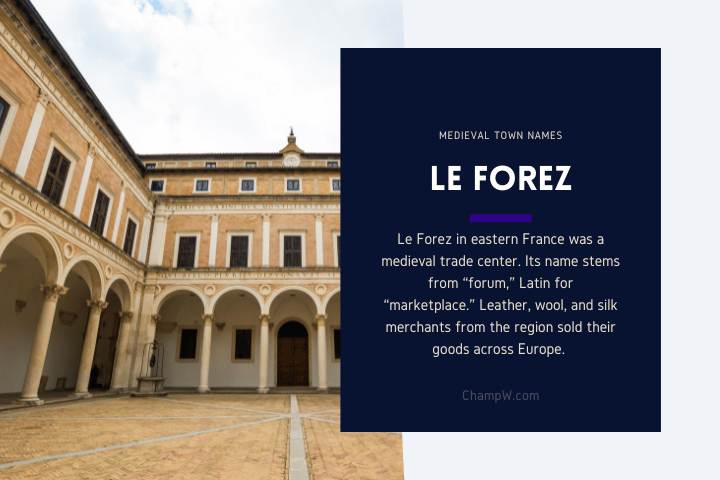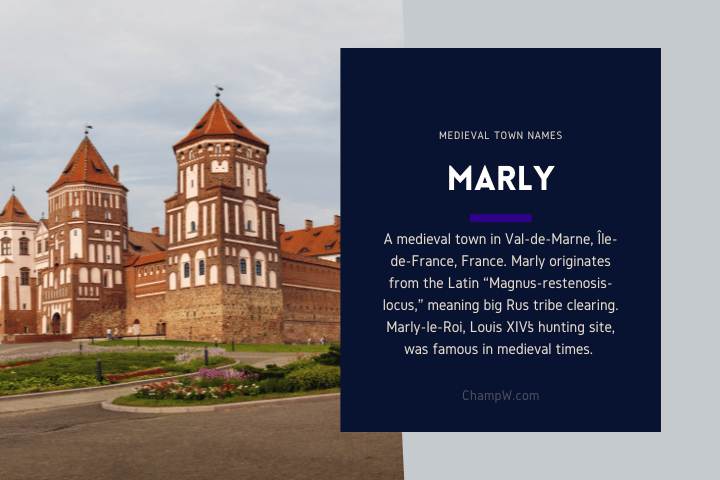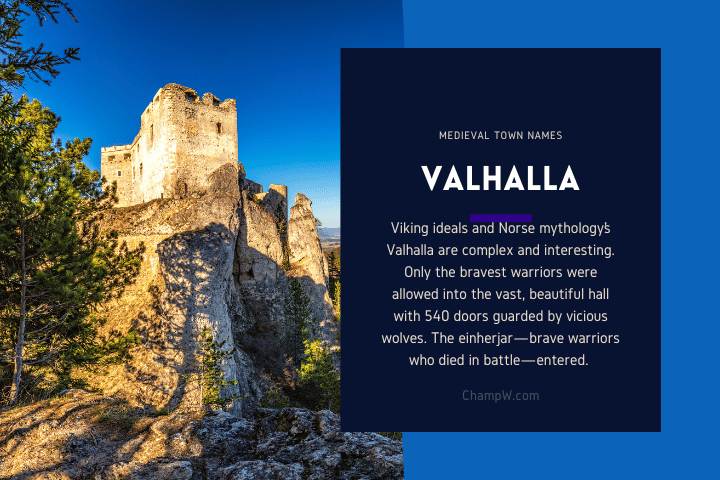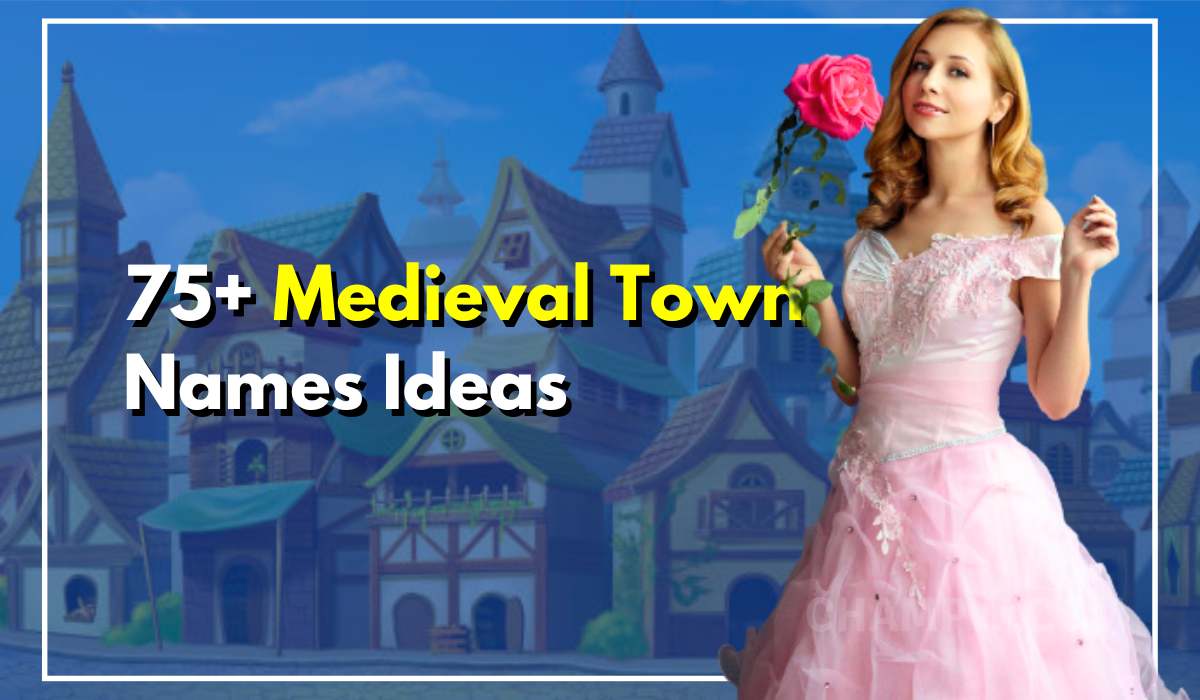Names from history often appear as we walk through history. Every town has its own tale from the medieval period. Medieval communities showcase a bygone era with castles and cobblestone streets. Join us as we explore the winding alleyways of history to find medieval town names that will spark your imagination.
Medieval towns await! Walled towns, narrow alleys, and spectacular architecture made the Middle Ages interesting. The towns’ romantic names reflect their importance in molding this period’s culture, economy, and society. This blog explores some of the most intriguing medieval town names, their history, and their importance. Sit back and join us as we explore the origins of these unique town names in the Middle Ages.
Europe saw a rapid transition from the 5th through the 15th centuries. Many towns and cities were founded during this time, each with its own history and significance. The names of these historic communities passed down through centuries, intrigue us when we look back. Each medieval town is unique, from Camelot’s romance to Constantinople’s grandeur. This blog examines the List of Mediaeval Town Names and their rich history and relevance. Discover and appreciate the towns that shaped our world with us.
Medieval Town Names
Step back in time and immerse yourself in the fascinating world of medieval town names from mythology. These names evoke tales of heroes, gods, and mythical creatures, and transport us to a time of chivalry, magic, and adventure. Each town carries its own unique history and story, and discovering the origins of their names is like unraveling the threads of a captivating tapestry. Join us on this journey as we delve into the enchanting realm of medieval mythology, and explore some of the most captivating and thought-provoking town names of the era.
- Hainers grün—a mediaeval German town. Hainers grün means “meadow green of the Hainer family” and was called after the local Hainer family. The 13th-century village was noted for agriculture and animals. After the German Peasants’ War in the 16th century, the town was rebuilt.
- Warminster—A medieval town in southwest England with Saxon roots. Warminster means “minster on the River Were” because of its proximity to the river. Warminster thrived in the medieval period due to its wool commerce.
- Southwest England’s medieval Taunton. Taunton derives from the old English words “tun” meaning settlement and “tonne” meaning town, referring to the fortified settlement that previously existed there. Due to its riverside location, Taunton was significant in English history. It was a prosperous medieval market town and cloth producer. Due to its history and attractiveness, Taunton is a popular tourist destination.
- Towcester—Northamptonshire’s historic market town. The Old English word “tóse coaster,” meaning Roman fort to the north, refers to a neighboring Roman colony. Towcester was famous for its wool trade and fabric industries in medieval times. The village hosted a 1649 English Civil War combat. Towcester’s history and culture draw tourists to its combination of old and modern architecture.
- Poole—Dorset’s coastal town Poole. The town’s magnificent harbor and protected waters inspired its Celtic name, “pool,” meaning refuge or sanctuary. Poole, a medieval trading town, traded fish, wool, and textiles. Its strategic location made it a significant commercial port and a key part of England’s nautical history. Poole’s beautiful beaches, vibrant nightlife, and cultural legacy draw tourists today.
- Marly—A medieval town in Val-de-Marne, Île-de-France, France. Marly originates from the Latin “Magnus-restenosis-locus,” meaning big Rus tribe clearing. Marly-le-Roi, Louis XIV’s hunting site, was famous in medieval times. The estate attracted rich nobles and symbolized authority. Marly is a pleasant town with wonderful natural spaces, and visitors may see the relics of the royal estate, including the spectacular hydraulic Machine de Marly, which pumps water upward.
- Cornaut—An historic town in Powys, Wales, near Herefordshire, England. “Cornaut” may stem from the Welsh words “Corn” and “Autr,” which indicate “horn-shaped peak” and “fortress,” respectively. Cornaut, a medieval fortified town, helped Wales fight the English invasion.
- Surrey’s historic Reigate. Its name comes from the Old English words “rāgeat” and “port,” meaning “the entrance to the pasture.” Reigate’s medieval market and wool trade date back to the Roman era. Queen Victoria frequently stayed at nearby Reigate Castle. Visitors come to Reigate to experience its rich history and beautiful surroundings.
- Eashing—A Surrey settlement. The Old English words “ēast” and “ing,” meaning “eastern people,” relate to the Saxons who colonized the area. Eashing’s medieval farming and milling enterprises relied on river-powered mills. Historic and modern homes give the village its appeal. Many painters have been influenced by the surrounding countryside and river walks. Breweries and pottery studios are also in Eashing.
- Flandre—A historic region in northern France, Belgium, and the Netherlands. Its name may stem from Old Norse “Flandr,” meaning “flat land.” Flandre was a prosperous medieval trading region famed for its woolen textiles and commercial ports like Bruges and Ghent. Jan van Eyck and Hans Memling were Flandre-born artists.

Cool Medieval Town Names
Medieval and mythical towns have wonderful names that recall heroes and legends. These villages give a glimpse into the past and a portal to a period of mythology and legend. Every name tells a tale and captivates our imagination with its enchantment and intrigue. This blog article will examine some of mythology’s most intriguing medieval town names and their legends. Ready to explore medieval town names? Let’s start!
- Ronnay—Isle of Man settlement Ronnay. Its name is Manx Gaelic “Rhonee,” meaning “pointed hill.” Ronnay was a medieval Christian center on the island, with many churches and monasteries. The village was noted for its fishing and as a layover for Isle of Man-Ireland ships.
- Huntingdon—A medieval English town. Its name stems from Old English “hunt” and “dun,” meaning “hunter’s hill.” In 1066, the town helped the Normans conquer England and afterward became a market town and wool center. Oliver Cromwell, the 17th-century Lord Protector of England, was born in Huntingdon.
- Bruges—Bruges, a charming Belgian city, was a medieval trade hub. Its name stems from the Old Norse word “bryggja,” meaning “harbor,” because the city stood at the mouth of the river that went into the North Sea. Bruges merchants helped build European trade through their cloth industry. Bruges’ Belfry and Church of Our Lady are also spectacular.
- Tüchlewitz—A medieval German town, Tüchlewitz is rarely known. Its name stems from Old Germanic “tüchel” and “Witz,” meaning “little hill” and “witty.” Salt commerce along the Elbe possibly founded the town in the 13th century. Martin Luther and other Protestant Reformers visited Tüchlewitz in the 16th century. Tüchlewitz’s charm and character reflect medieval Europe’s rich history despite its tiny size and relative obscurity.
- le Forez—Le Forez in eastern France was a medieval trade center. Its name stems from “forum,” Latin for “marketplace.” Leather, wool, and silk merchants from the region sold their goods across Europe. Le Forez had various Catholic monasteries and convents.
- Saint Urbain—Le Forez was a medieval French feudal district. Its name comes from the Latin word “forensic,” meaning “forest,” because of the region’s thick woods and woodlands. Gold, silver, and other precious metals made Le Forez an economic hub. The region’s castles and chateaux also influenced the time’s wars and alliances.
- Saint Urbain—A medieval French village, Saint Urbain has a rich religious and cultural past. Saint Urban, a 3rd-century pope noted for his piety and Christian faith, gave the town its name. Saint Urbain, a medieval pilgrimage place, helped local Christian communities grow. The town’s majestic Saint Urban church exemplifies medieval faith and architecture.
- Pochlolitz—A medieval Czech town, Pochlolitz has a rich cultural legacy. Its name comes from Old Slavic “pochvala” and “lic,” meaning “praise” and “face.” The 13th-century village produced salt and lumber, valuable commodities in medieval Europe. Pochlolitz also helped Bohemian Hussites rebel against the Catholic Church in the 15th century.
- Friaize—A medieval French commune, Friaize is lovely. The town’s name comes from the Latin word “friend,” meaning “peaceful,” and it thrived in trade and commerce during the Middle Ages. Friaize helped develop the region due to its strategic location near the Loire River. Several Catholic religious groups built monasteries and convents in France.
- Champagne—The northeastern French region of Champagne is famous for its sparkling wine and history. Medieval merchants in the region were skilled in textile production. Champagne was home to many Catholic monasteries and cathedrals. Champagne is where Bishop Saint Nicasius was born.
- l’Isle
- Trasignies
- Menoncourt
- le Mez
- Ronsoi
- Virsin

Medieval Town Names from Mythology
Medieval towns like Camelot and Atlantis captivate us with their tales of adventure and romance. These communities’ tales are not only stories but a rich cultural history passed down through centuries. This blog will revisit a collection of mythological medieval town names, each with its own narrative and charm. Immerse yourself in mythology’s most interesting medieval towns.
- Akhet—The City of the Sun—is one of mythology’s lesser-known medieval towns. Akhet was an ancient Egyptian city with advanced astronomy and astrology. Akhet worshipped the Sun as a god. The town’s solar calendars and observatories were aligned with the Sun.
- Land of Manu—Hindu mythology’s medieval town of Manu is intriguing. Manu governed the utopian Land of Manu, according to Hindu texts. The inhabitants lived in harmony and abundance in this place. Many legends, like Noah’s Ark, feature a huge deluge that destroyed the Land of Manu.
- El Dorado—El Dorado is a mythical medieval town. It was claimed to be a gold metropolis hidden in South America’s huge rainforests. Many explorers sought El Dorado to claim its riches. El Dorado eluded all attempts. Its mythology symbolizes greed and unfathomable fortune.
- Valhalla—In Norse mythology, Valhalla was a grand hall in the afterlife where brave warriors who died in battle spent eternity. Odin, the Norse deity of wisdom, war, and death, selects Valhalla’s soldiers. Warriors prepare for Ragnarok by feasting, drinking, and fighting in Valhalla. Valhalla symbolizes Viking honor, courage, and loyalty.
- Fortunate Isles—The Isles of the Blessed figure in Greek, Celtic, and Welsh myths. The gods or blessed dead lived in them, a legendary paradise beyond the known world. The Fortunate Isles were thought to have perfect happiness, health, and prosperity, free from all sadness and suffering. The Fortunate Isles symbolize our desire for a better life beyond our mortal planet.
- Kvenland—A mythical medieval town from Finnish folklore. Kvenland, in the north, was noted for its hunters and fishers. Kvenland was ruled by Kvensa, a wise and kind king. Kvenland shows how Finnish culture values community and nature.
- Valhalla—Viking ideals and Norse mythology’s Valhalla are complex and interesting. Only the bravest warriors were allowed into the vast, beautiful hall with 540 doors guarded by vicious wolves. The einherjar—brave warriors who died in battle—entered. The einherjar was promised eternal life in Valhalla, fighting and feasting until Ragnarok. Valhalla was home to the einherjar, Odin, Thor, and other gods, as well as Valkyries who selected and transported slain warriors. Viking culture emphasizes war, heroism, loyalty, honor, and heavenly protection, which Valhalla symbolizes.
- Naraka—Hinduism and Buddhism describe Naraka as a place where souls are punished for their crimes after death. Naraka, controlled by Yama, is a Hindu underworld where souls are tortured according to their karma. Buddhism’s Naraka has multiple penalty levels depending on sin severity. Naraka emphasizes morality and life’s repercussions. Hindu and Buddhist culture believes in the cycle of birth, death, and rebirth.
- Moving Sands—Also known as quicksands, moving sands are loose sand or dirt that can envelop anyone who treads on it. It symbolizes peril and unpredictability in many mythologies. Moving sands were blamed on gods or malevolent spirits who punished those who entered their area. It symbolized the unknown and adventure risks in others. Moving sands remind us to be careful and appreciate nature. It also expresses human fear of the unknown and the need for stability and security.
- Matarta—In Indonesian mythology, Matarta is a strong, all-knowing goddess who controls fertility and plenty. Farmers and people respect Matarta because she governs harvests, rains, and plant and animal growth. If disrespected, Matarta can withhold her blessings. Matarta emphasizes Indonesian culture’s importance of nature and the necessity for humility and appreciation for the earth’s resources. It also expresses faith in the supernatural and heavenly influence on human existence.
- Celliwig—Welsh mythology describes a forest or grove that leads to the Otherworld. Spirits and supernatural beings live in the Otherworld. Welsh folklore associates Celliwig with the Otherworld god Arawn, who rules the underworld. Celliwig symbolizes the magical, mysterious zone between life and death. It also symbolizes the belief in life after death and the divine’s power over matter.
- Mictlan—Mictlan is the Aztec underworld controlled by Mictlantecuhtli, the Lord of the Dead. Before reaching the hereafter, deceased souls must pass through nine Mictlan levels. Only those who passed each level’s challenge could continue. Mictlan emphasizes death and the cycle of life in Aztec civilization. It emphasizes that life’s choices impact one’s fate, even after death.
- Creutz hof
- Cookham
- Avesnes
- Poden
- Zellenrode
- Bossinney
- Sachsengrun

Funny Medieval Town Names
Gods and goddesses dominated medieval mythology. Beyond old deities, this time’s towns have colorful and humorous names. These names may sound silly to modern ears, but they reveal medieval humor and ingenuity. In this blog, we’ll study some of the medieval times’ most bizarre town names and appreciate their peculiar appeal.
- Tetbury—A Cotswolds market town. Today’s architecture and streets reflect the town’s medieval wool commerce. Due to its strategic location, Royalist and Parliamentary forces targeted Tetbury during the English Civil War. The town’s rich history and modest appeal draw tourists from around the world to explore England’s medieval past.
- Od— Od— Some town names come from their geography, but others are more obscure. Od, a Danish village, is one example. According to legend, Od, a monster who terrorized the locals, gave the town its name. After a tremendous struggle, the giant was vanquished and killed, and the town was renamed in his honor.
- Gatton, Gatton. Gatton, Queensland, appears to be an ordinary town. Its name has a more intriguing history. Wild cats plagued the town’s early European settlers. A group of settlers agreed to round up the cats and compete to catch the most to fix the problem. The town was named “Gatton” by the contest winner, a combination of “cat” and “town.”
- Cône, France, has a simple name but a rich history. Cône was a center of Jewish scholarship and culture in the Middle Ages, producing many notable Jews. The community was evicted in the late 13th century, leaving the town deserted. Cône was repopulated centuries later with the same name as the old settlement to honor its history.
- Bra— Bra The origins of northern Italy’s Bra town are unknown. Due to its position on the Tanaro River, some believe the town’s name comes from “brachium,” Latin for arm. As the town lies at the foothills of the Alps, some believe the name comes from the Celtic word “brigade,” meaning hill. The bra is recognized for its food and wine culture, with several local delicacies.
- Rye— Rye Rye, a historic town in southeast England, has a simple name. Its name reflects its turbulent medieval past when its location near the English Channel made it a target for invasion. “Rye” comes from the Old English “rage,” meaning “at the river’s mouth.” The Rother and Brede rivers, which flow into the sea, meet at the town. Rye’s smuggling and piracy history added to its allure. Rye’s attractive streets and heritage draw tourists today.
- Foders Reuth—The German town of Foders Reuth may not be well-known globally, but locals value its name. “Reuth” is a frequent German town name suffix that means a cleared woodland or newly farmed field. “Foders” is peculiar to this town and gives its name a unique twist. Foders, a farmer from ages ago, fought off a band of bandits who terrorized the inhabitants. Folders won and the town was named for him. Foders Reuth, a pleasant rural village, honors its namesake.
- Zedbitz—A little Israeli town with a science fiction name. The town’s name comes from the Hebrew words “zed,” meaning righteous, and “bitz,” meaning haughty. The town’s unique name honors its foundational values of fairness and humility and reminds citizens to uphold them. Zedbitz people are proud of their communal spirit and lovely scenery. Zedbitz’s peaceful settings inspire numerous artists, writers, and musicians.
- Pintel—The Dutch town of Pintel has a rich history and legend. The town’s name derives from a Dutch phrase meaning “pile of wood,” recalling its timber industry roots. Some believe Pintel comes from a broader term that meant “place of the pine tree.” This belief is reinforced by the town square’s enormous pine tree, which is claimed to have been planted by the “Pine Man.” The Pine Man’s tree symbolizes Pintel’s citizens’ hope and persistence since local mythology says he foresaw the town’s expansion and prosperity. Today, Pintel attracts tourists from throughout the world with its beautiful beauty and rich cultural legacy.
- Aldermaston
- Pograth
- Milbach
- Hungern
- Chaumont
- Nemours
- Wurtz bach
- Newenden
- Bretford
- Reisag
Medieval village Names
Villages and towns were vital to medieval life. People lived, worked, and established societies and cultures in them. Medieval village names are fascinating. These names come from mythological and historical personalities. This blog examines mythological medieval village names. Explore the mythology and history behind these charming village names.
- Eger—Let’s examine medieval Hungary’s Eger. Eger comes from the Hungarian word “egri,” meaning “meadow.” The town’s history is mythical. The mythical great-grandson of Noah, Nimrod, founded the town. After the Great Flood, Nimrod founded Eger.
- Lohja—A medieval village in southern Finland, Lohja is fascinating. Lohja comes from the Norse word “lo,” meaning “salmon.” Due to its fishing industry, the town was a medieval commercial center. Lohja is also mythological. Finnish mythology’s principal god of thunder and sky, Ukko, established the town.
- Avalon—King Arthur was buried on this mythical island.
- Tintagel—King Arthur was conceived in this hamlet.
- According to Norse mythology, the gods lived in Asgard.
- Camelot—King Arthur’s castle and court were supposed to be in Camelot.
- Wilton—Wilton, a medieval hamlet in Wiltshire, England, is named after Old English for “place by a stream.” The village is also mythical. West Saxon king Cynric defeated British king Natanleod at Wilton, according to mythology. In another narrative, a gallant knight fought a giant who terrorized Wilton’s residents.
- Avalanche—Not a medieval village name, but intriguing. “Avalanche,” from French, meaning “a sudden and violent descent of snow and ice.” Medieval people believed that God sent avalanches to punish sinners. Avalanches in hilly areas near monasteries or other holy sites supported this view.
- Hamer—A charming medieval town in North Yorkshire, England. The Old Norse word “hammer,” meaning “rock,” relates to the village’s rocky protrusion. Norse mythology also links the village. Thor, the Viking deity, is said to have slammed his hammer on the ground to create a spring after being awed by the region. Thor’s Well was a healing spring. Some legends say King Arthur fought at the village.
- Alttentheich—Austrian mediaeval village Alttentheich means “Old Pond.” The community has a rich mythology despite its modest name. A courageous knight fought a dragon in Alttentheich, according to one tale. The knight defeated the dragon and saved Hamlet after a hard battle. A local witch protected the villagers with her charms. Her magic came from the village’s historic pond. Folklorists and mythologists go to Alttentheich for these tales.
- Fenny Stratford— Fenny Stratford is a small medieval village in Buckinghamshire, England, named after the Old English terms “fenny” meaning marshy and “strat” meaning street. The Hamlet has a rich history despite its unimpressive name. Several medieval guilds traded there.
- Höfferlandt
- Rheims
- Coventry
- Saint Michel
- Manchester
- Northwich
- Autrèche
Also Read—
Final Words
The List of Medieval Town Names provides a fascinating insight into the historical, religious, economic, and political forces that shaped medieval Europe. It reminds us of the wealth of heritage and culture that we have inherited from this period and the enduring influence of these towns on the modern world. Whether it’s the religious significance of Bethlehem or the economic vibrancy of Venice, each town has a unique story that enriches our understanding of the past. As we continue to explore the rich tapestry of medieval Europe, we can draw inspiration from the names and legacies of these towns and the people who lived in them.
